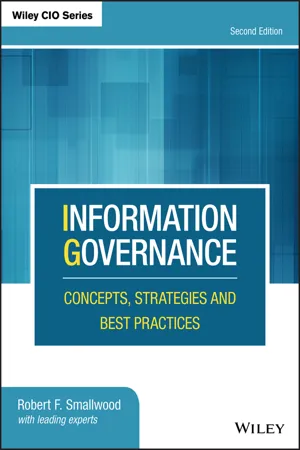
Information Governance
Concepts, Strategies and Best Practices
Robert F. Smallwood
- English
- ePUB (apto para móviles)
- Disponible en iOS y Android
Information Governance
Concepts, Strategies and Best Practices
Robert F. Smallwood
Información del libro
The essential guide to effective IG strategy and practice
Information Governance is a highly practical and deeply informative handbook for the implementation of effective Information Governance (IG) procedures and strategies. A critical facet of any mid- to large-sized company, this "super-discipline" has expanded to cover the management and output of information across the entire organization; from email, social media, and cloud computing to electronic records and documents, the IG umbrella now covers nearly every aspect of your business. As more and more everyday business is conducted electronically, the need for robust internal management and compliance grows accordingly. This book offers big-picture guidance on effective IG, with particular emphasis on document and records management best practices.
Step-by-step strategy development guidance is backed by expert insight and crucial advice from a leading authority in the field. This new second edition has been updated to align with the latest practices and regulations, providing an up-to-date understanding of critical IG concepts and practices.
- Explore the many controls and strategies under the IG umbrella
- Understand why a dedicated IG function is needed in today's organizations
- Adopt accepted best practices that manage risk in the use of electronic documents and data
- Learn how IG and IT technologies are used to control, monitor, and enforce information access and security policy
IG strategy must cover legal demands and external regulatory requirements as well as internal governance objectives; integrating such a broad spectrum of demands into workable policy requires a deep understanding of key concepts and technologies, as well as a clear familiarity with the most current iterations of various requirements. Information Governance distills the best of IG into a primer for effective action.
Preguntas frecuentes
Información
PART ONE
Information Governance Concepts, Definitions, and Principles
CHAPTER 1
The Information Governance Imperative
Early Development of IG
Big Data Impact
Índice
- COVER
- TABLE OF CONTENTS
- PREFACE
- ACKNOWLEDGMENTS
- PART ONE: Information Governance Concepts, Definitions, and Principles
- PART TWO: Information Governance Risk Assessment and Strategic Planning
- PART THREE: Information Governance Key Impact Areas
- PART FOUR: Information Governance for Delivery Platforms
- PART FIVE: Long-Term Program Issues
- APPENDIX A: Information Organization and Classification: Taxonomies and Metadata
- APPENDIX B: Laws and Major Regulations Related to Records Management
- APPENDIX C: Laws and Major Regulations Related to Privacy
- GLOSSARY
- ABOUT THE AUTHOR
- ABOUT THE MAJOR CONTRIBUTORS
- INDEX
- END USER LICENSE AGREEMENT